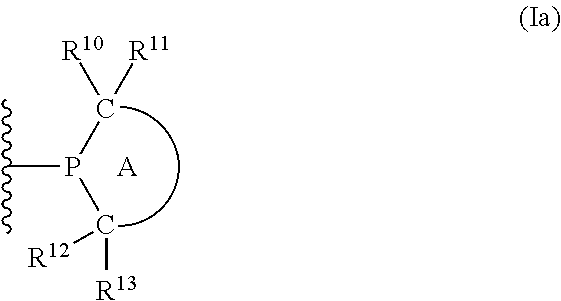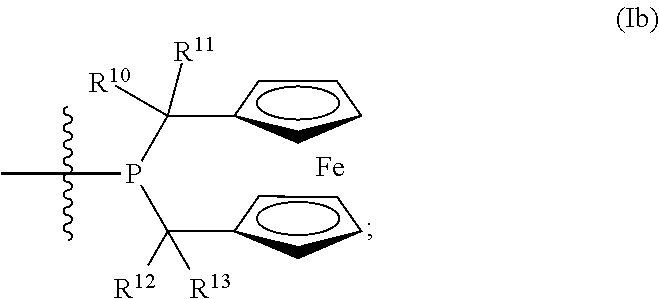Phosphine ligands for catalytic reactions
- Summary
- Abstract
- Description
- Claims
- Application Information
AI Technical Summary
Benefits of technology
Problems solved by technology
Method used
Image
Examples
example 1
Synthesis of Ligands Containing 6-Membered Phosphacycles
[0293]
[0294]Examples 1-a, 1-b, 1-c, 1-d, and 1-e were synthesized using the general method described in Scheme A′.
[0295]Ethyl 2′,4′,6′-triisopropylbiphenyl-2-ylphosphinate: A 1-L 3-neck round-bottom flask was fitted with an addition funnel and the atmosphere was purged with nitrogen. Anhydrous, degassed THF (170 mL) was added to the 1-L flask and cooled to −60° C. (internal temperature). The addition funnel was charged with hexyllithium (2.38 M in hexanes, 57 mL, 135 mmol, 2.0 equiv). The hexyllithium was transferred into the cold THF over 20 min, maintaining the temperature below −40° C. The solution was re-cooled to −60° C. (internal temperature). A solution of 2′-iodo-2,4,6-triisopropylbiphenyl (27.5 g, 67.7 mmol, 1.0 equiv) in 170 mL of anhydrous, degassed THF was transferred, via cannula, drop wise to the n-hexyllithium solution. This was done over 25 min while maintaining the temperature below −40° C. After addition, the ...
example 1-a
2,2,6,6-tetramethyl-1-(2′,4′,6′-triisopropylbiphenyl-2-yl)phosphinane
[0298]
[0299]A flask was charged with 1.05 g of 2,2,6,6-tetramethyl-1-(2′,4′,6′-triisopropylbiphenyl-2-yl)phosphinan-4-one (2.33 mmol, 1.0 equiv), the atmosphere was sparged with argon and 12 mL of argon-sparged diethylene glycol was added. The flask was mounted with a Dean-Stark trap and condenser to collect distillate. The mixture was charged with 1.05 mL of hydrazine hydrate (55 wt % hydrazine, 11.7 mmol, 5 equiv) and 0.77 g of potassium hydroxide (88 wt %, 12.1 mmol, 5 equiv) and the mixture was immersed in an oil bath at 115° C. under an argon atmosphere. The temperature of the bath was gradually increased to 200° C. over two hours and kept at that temperature for 5 h. The reaction mixture was cooled to room temperature under argon gas. The reaction mixture was partitioned between heptane and water. The organic solution was washed once with 0.1 M aqueous hydrochloric acid, once with 10 wt % aqueous sodium carbo...
example 1-b
2,2,6,6-tetramethyl-1-(2′,4′,6′-triisopropylbiphenyl-2-yl)phosphinan-4-one
[0300]
[0301]A flask was charged with 10.8 g of (2′,4′,6′-triisopropylbiphenyl-2-yl)phosphine (66% potent, 7.13 g, 22.8 mmol, 1.0 equiv) and 6.6 g of 2,6-dimethyl-2,5-heptadien-4-one (47.7 mmol, 2.1 equiv). The vessel was purged with argon gas and immersed in an oil bath at 170° C. with magnetic stirring. The flask was sealed with a Teflon stopcock and the reaction was allowed to proceed under a static argon atmosphere. The flask was removed from the oil bath after 14 h and the contents allowed to cool to room temperature under argon gas. Anhydrous ethanol (70 mL) was added to the unpurified solids and the solids were broken up manually. The slurry was warmed to 80° C., held for an hour, and cooled to room temperature. The product was isolated by filtration, washes with ethanol and dried in vacuo to give 7.82 g of 2,2,6,6-tetramethyl-1-(2′,4′,6′-triisopropylbiphenyl-2-yl)phosphinan-4-one (98 area % by HPLC, 74%...
PUM
| Property | Measurement | Unit |
|---|---|---|
| Fraction | aaaaa | aaaaa |
| Fraction | aaaaa | aaaaa |
| Fraction | aaaaa | aaaaa |
Abstract
Description
Claims
Application Information
 Login to View More
Login to View More - R&D
- Intellectual Property
- Life Sciences
- Materials
- Tech Scout
- Unparalleled Data Quality
- Higher Quality Content
- 60% Fewer Hallucinations
Browse by: Latest US Patents, China's latest patents, Technical Efficacy Thesaurus, Application Domain, Technology Topic, Popular Technical Reports.
© 2025 PatSnap. All rights reserved.Legal|Privacy policy|Modern Slavery Act Transparency Statement|Sitemap|About US| Contact US: help@patsnap.com



